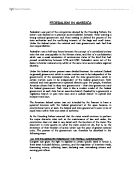Roosevelt’s “New Deal” of 1933 had a substantial amount of policies struck down by the Supreme Court on the basis that they “encroached upon intrastate matters.” This obviously angered FDR who took the chance to re appoint judges who took his point of view and so the controversy over the matter grew as it became partizan and party politics took over.
Although FDR didn’t get his plans passed, two judges (Justice Roberts and Chief Justice Hughes) swapped sides in what was known as "the switch in time that saved nine". This gave way to the National Labor Relations Act, which resulted in the gaining greater power over the country’s unions.
This era of the Federal Governments power enlarging culminated with (). The Agricultural Adjustment Act was upheld even though it applied to wheat grown for homemade consumption. For many this was the final straw. Yet still cases came to court and were passed increasing Federal Government power.
1995 marked the end of this trend of expansion with The United States of America vs. Lopez. Justice Rehnquist ruled that Congress only had the power to “…regulate the channels of commerce, the instrumentalities of commerce and action that substantially effects interstate commerce…” However essentially not the power to regulate relatively unrelated things (for example the possession of firearms near schools). This was the first time a ruling had gone this way since the “New Deal” arguments of the 30’s.
-
Distinguish between Dual and Cooperative Federalism.
It is generally accepted that Dual Federalism is the term used to describe the relationship between the states and the federal government for the first 150 years of American politics. For the majority of the 20th Century, up until the 1960’s, Cooperative Federalism was believed to be the best description of the relationship. In its simplest description Dual Federalism was known as “layer cake” due to both parts of government being distinctly separate and Cooperative Federalism was known as “marble cake” due to its merging of state and federal government.
Tillson describes Dual Federalism as having “…clear distinctions between the separate and equal spheres of activity of state and national government…” There was also a lot of argument over economic development and regulation. Yet both governments did cooperate on certain issues such as the development of the United States. There was virtually no financial cross over although limited grants were provided for universities and transport. After the Civil War, the passing of the 14th Amendment was of great consequence as it re defined the liberty of the states. Economically this lead to much greater involvement from the Federal Government. In 1862, the Morrill Act was the first example of national government participating in state welfare, it involved educational investment. This shows how gradual the change from one type of Federalism to another was. Another milestone was the 16th Amendment of 1913 that gave taxation powers to the national government; Tillson describes this as a “watershed for modern federalism”. The USA was a changing country and so the government had to change with it. By 1920 there were eleven grant in aid programs. Court rulings decided that if states didn’t like these plans they could simply leave, none did. Whilst these changes were gradual, it was at this point, the 1930s, that Cooperative Federalism most prominently came into being.
Vaguely speaking Cooperative Federalism lasted from the 1930s to the 1960s, but this is a far too simplistic as both types of Federalism merged into one and there is no definitive time scale.
This is a period where federal government became more powerful, sometimes at the expense of the states. This era was overseen by Truman’s “Fair Deal”, Kennedy’s “The New Frontier” and Johnson’s “The Great Society”. However it all began with Roosevelt’s “New Deal”, a landmark policy in American politics. Although Cooperative Federalism started before 1933 with the 16th Amendment (e.g. revenue sharing), the New Deal set a precedent for modern federalism, since then states have been more and more reliant on central investment.
Some have even argued that the “New Deal” took such control of state funding that it took federalism away from what the founding fathers set up. Due to the Great Depression, America looked to their government for help. As Tillson says, “…The New Deal embodied the view that a national crisis requires a centralised response…” This, at the time, was a brave new view of how America should be run. The Supreme Court, for one, was against it. In 1935 it ruled that the National Recovery Administration was unconstitutional and commenting that “extraordinary conditions do not create or enlarge constitutional power”. However the Court came round to public opinion by 1937 when numerous decisions were reversed, the National Labour Relations Board vs. Jones & Laughlin being a landmark case where federal government took control over labour relations. It also took power of certain areas of economic regulation and set up a welfare state of sorts, in the form of the Social Security Act of 1935. This act resulted in “…different levels of government working together towards common objectives to overcome the challenges of poverty, unemployment and homelessness…” (Tillson). Many social support programs were still under state control but still with federal limitations. Finally there was Eisenhower who tried to implement more state power by setting up the Commission on Inter governmental Relations. However it found little use to changing the system, proving that at that time cooperative federalism was the way forward.







